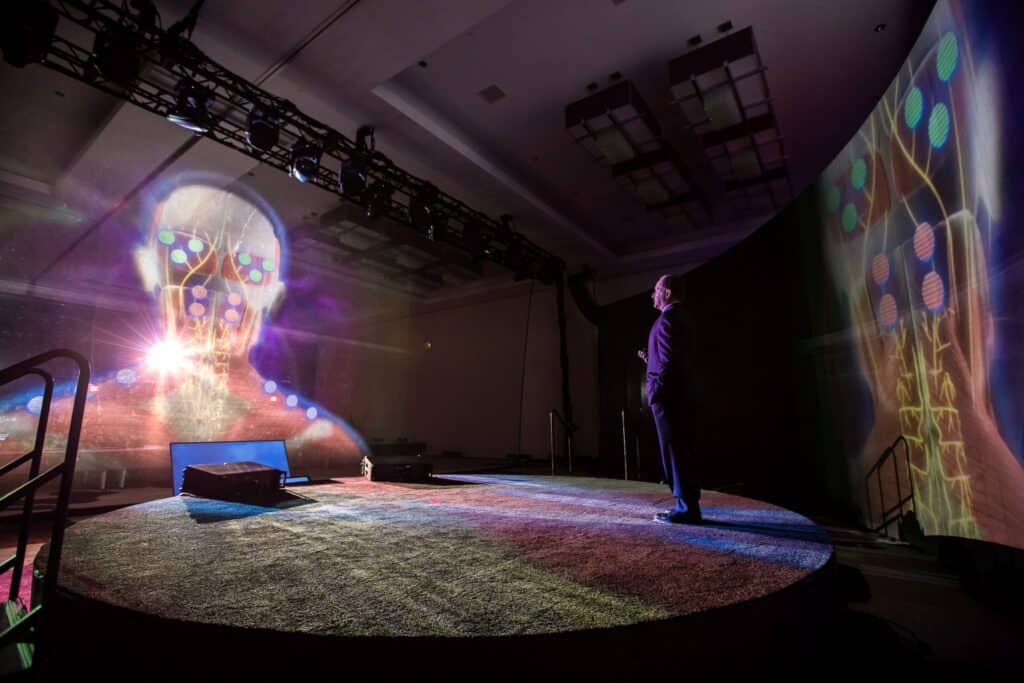As event technology evolves, communication becomes increasingly instantaneous and immersive. In the span of just two centuries, we’ve gone from sending letters on horse-drawn carriages to Facetiming with friends across the globe! With each new development, technology allows people to communicate more non-verbal cues, like vocal tonation and facial expressions.
In 2020, a new technology has raised the bar yet again. That technology is the hologram. The Greek translation of “hologram” means “message.” As the most comprehensive message medium yet, holographic telepresence is finding its place in events around the world, including world-renowned music festivals and high profile business conferences.
What is a Hologram?
A hologram is a 3D image that can be seen by the naked eye. Like 2D photographs, holograms mirror real-life visuals by reflecting light in a specific way. The main difference is that holograms allow light to reflect in a three-dimensional manner with the use of laser projection technology.
A digital hologram is a form of Augmented Reality (AR), which presents computer-generated elements within the real world. As a result, holographic images look incredibly life-like. If you walk around one, the hologram will appear to be real, maintaining 3D-visuals from every angle.
The History of Holograms
Holograms were invented in 1947 by Dennis Gabor, who won a Nobel Prize for his development. By 1962, 3D hologram technology was made possible with laser recordings. As of 2015, holograms have become increasingly interactive. For example, Japan’s “Fairy Lights” hologram is responsive to human touch.
Fast forward to 2020 and you can find holograms gracing the stages of Coachella, the Billboard Awards, and various other concerts across the country. Here are a few of the most famous hologram performances from the past decade:
- Tupac’s performance at Snoop Dog’s Coachella 2012 headlining show
- Michael Jackson’s performance at the 2014 Billboard Awards
- I.A and Janelle Monae’s duet as they performed simultaneously from separate stages located in LA and New York
Not only do holograms bring life to late performers, but they also allow presenters to appear on multiple stages at once. This is what makes them so useful within the events industry.
The Growing Hologram Market
The digital hologram market is growing fast. Here are some notable statistics about its current growth trajectory:
- The hologram market was worth $2.2 billion in 2019.
- The hologram market is projected to be worth $5.4 billion by 2024, a 20% increase from 2019!
- The commercial sector currently holds the largest slice of the hologram market.
- Experts predict that the commercial sector will continue to adopt holograms at a faster rate than any other sector for the foreseeable future.
Holograms dominate within the commercial sector because they are incredibly engaging at events. They impress and excite audiences of customers and employees alike. From live streaming events to product launches, digital holograms have a lot of potential applications within commercial industries.
How Does a Hologram Conference Work?
Many conferences are making use of holograms these days in the following ways:
- Showcasing remote keynote speakers
- Combining real-life and holographic presenters on one stage
- Displaying new product lines and merchandise
- Featuring interactive art displays and branded decor
Rather than going through the hassle of setting up a heavy product display or paying hefty travel expenses for your keynote speaker, simply beam them in with a hologram. With their high definition imagery, your audience will have to do a double-take to determine if they are real or not.
In terms of setting up the technology, leave it to hologram technicians. They will organize everything you need, including the required holographic projection equipment and software. Once their work is done, you’re ready to dazzle your conference-goers with an impressively life-like simulation.
Why Use A Hologram Presentation?
Even if your next conference isn’t Coachella, you probably still want it to be noteworthy, fun, and engaging for your attendees. While conferences differ from music festivals in many obvious ways, their use of holograms is actually quite similar.
Holograms generate a buzz, no matter what type of event they’re used at. They allow presenters to reach audiences remotely from distant locations. Most importantly, holograms enhance audience engagement due to people’s fascination with them.
For example, Audi turned heads in 2017 with their first-ever holographic press conference for their Audi Cup in Germany. This event included various coaches on stage, some real and some beamed in via hologram. As a result, the press conference generated a lot of extra attention and press.
The Many Benefits of Hologram Conferences
It’s clear that companies will be showcasing more holograms in the future. Here are the main reasons why you should consider holograms for your next event:
- They enhance engagement.
- They give your speakers access to a broader audience.
- They’re a convenient medium for speakers with busy schedules.
- They can reduce the costs of putting on presentations.
Let’s take a deeper look at each of these benefits.
They Enhance Audience Engagement
A key success metric for any event is engagement. If your audience leaves inspired, impressed, and excited to talk about the event, you know you did your job right. This is true of business conferences and music festivals alike.
Hologram presentations help you do just that. They offer a novel experience to your audience. Attendees will be fascinated with their innovative technology. The immersive experience of witnessing a hologram is sure to make your event the most memorable one of the year.
By using a hologram, you can transform a stiff business event into an extraordinary moment for everyone involved. As people share about their experience, both in person and online, your company will enjoy positive attention and free word-of-mouth marketing.
They Allow Coveted Speakers to Reach a Broad Audience
Holograms cross the barriers of time and space. In turn, holographic telepresence enables you to showcase speakers at multiple events, either simultaneously or at different times. You can also record presentations and make use of them for years to come.
If you have a conference that has multiple locations, you can beam in your speaker to all of them at once. For example, you could have your speaker put on a presentation shown to audiences in Los Angeles and New York, even though they’re physically located in London. This allows them to reach a larger audience without any additional traveling or time commitment.
While Facetime or Zoom could achieve a similar goal, these video services can’t compete with the 3D presence holograms. Not only will holographic visuals communicate more non-verbal cues, but they can also make a huge difference in an audience’s engagement and reception of information.
They Provide Speakers More Convenience
Holograms not only impress your event attendees, but they give speakers the convenience and flexibility of presenting remotely. Some of your presenters may be confined to one place for a variety of reasons:
- They are older and prefer not to travel
- They are dealing with a disease
- Their travel expenses are too costly
- They’re juggling a busy schedule of work obligations
- They need to remain close to home for family
With the use of holographic telepresence, nothing needs to stand in their way of imparting wisdom on a real-time audience. Holograms can virtually teleport them anywhere in the world. This will make experts much more likely to agree to speak at your next event.
Holographic telepresence can facilitate a presentation that’s almost identical to one where the person’s actually on stage in real life. Viewers will still be able to see the speaker’s body language, ask them questions, and feel their presence in the room.
They Lower the Costs of Putting On An Exceptional Event
Putting on an event is expensive, especially if you don’t want to skimp on the experience of your attendees’. Fortunately, holograms have the potential to cut many of the associated costs, from your speakers’ travel and accommodation expenses to your company’s custom decor.
Depending on the status and expertise of your chosen keynote speakers, their services can cost anywhere from $500-$100,000! In addition, you’ll be responsible for any of their airfare, transportation, and hotel expenses. By beaming them in with a hologram, you instantly cut many of these costs from the equation.
Speakers aren’t the only expensive attraction at events. If you have a product line, dragging it all in and setting it up will incur costs for labor and materials. It would be much speedier to beam in the big items and show them off in a flashier way via a hologram.
Hologram Conferences: The New Conference Norm
As you can see, holograms are no longer reserved for musical legends or sci-fi movies. They are becoming a popular and innovative trend for conferences due to their flexibility, convenience, and engaging appeal. Consider trying out this holographic technology at your next presentation, meeting, or trade show.
To see holograms in action, check out Vario’s custom event technology at Allergan’s Annual MIND Summit. Allergan is a leading international pharmaceutical company. Their conference tackles the topic of mitigating migraine headaches.
Vario made this conference a success by customizing a 60’ by 18’ holographic surface for the event. It allowed physicians to display their subject matter with 3D visuals, capturing the attention of the viewers. This allowed the audience of doctors, patients, and researchers to better understand neurological pathways in the brain relating to migraine headaches. It also kept them highly engaged throughout the entire event, to Allergan’s satisfaction. To learn more about event tech trends such as facial recognition events, contact Vario today.







